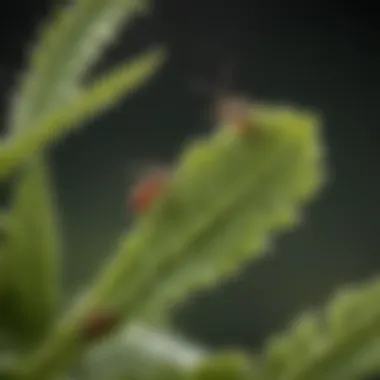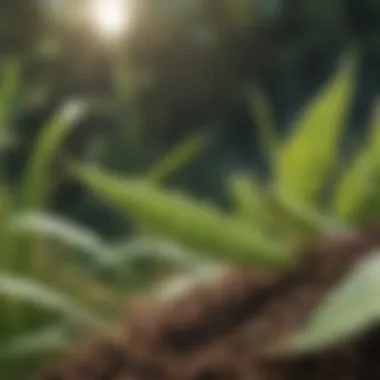Natural Ways to Effectively Eliminate Aphids


Intro
Aphids, small sap-sucking insects, can cause extensive damage to plants if they are not managed effectively. Their rapid reproduction and ability to thrive on various plants make them challenging pests. This article focuses on natural methods to eliminate aphids, ensuring that plant health is maintained without harmful chemicals. Understanding their biology and behavior is crucial in developing effective strategies against these pests.
In the following sections, we will explore innovative and organic solutions for controlling aphid populations. From utilizing natural predators to DIY remedies, each approach emphasizes the benefits of sustainability in gardening. Let's dive into an engaging journey of aphid control.
Fascinating Facts About the Animal
Unique Characteristics
Aphids are small insects, typically measuring 1 to 10 millimeters long. Their bodies are often green, black, or white, which varies among species. One fascinating aspect of aphids is their ability to reproduce rapidly; certain species can give birth to live young without mating—this is called parthenogenesis.
They possess a specialized mouthpart known as a stylet, allowing them to pierce plant tissues and extract necessary nutrients. Moreover, many aphids have distinctive features like cornicles, which are small tubes on their back that can excrete a waxy substance, often used to deter predators.
Extraordinary Abilities
Aphids are not mere pests but exhibit remarkable survival traits. They can form a symbiotic relationship with ants, which protect aphids in exchange for honeydew, a sugary secretion produced by the insects. Additionally, certain species can change color based on their environment—this adaptation aids in camouflage against predators.
Behavior and Habitat
Natural Habitats
Aphids can be found in various habitats, ranging from gardens to fields and even indoor plants. They thrive best in warm climates, where they can reproduce quickly. Often, they settle on the underside of leaves, which offers some protection from the elements and predatory threats.
Social Structures
Aphids exhibit interesting social behaviors. Some species live in colonies, often in large numbers, which helps to fend off predators through sheer volume. They communicate through chemical signals, and certain alarm pheromones can trigger a collective retreat when the colony is threatened.
Recent Scientific Discoveries
Latest Research Findings
Recent research has revealed the impact of environmental factors on aphid populations. Studies show that climate change, particularly increased temperatures, can lead to higher aphid infestations. Another key finding involves the identification of natural predators and their effectiveness in managing aphid populations.
Breakthroughs in Animal Biology
Advancements in biotechnology have allowed scientists to study aphid genetics more closely, leading to insights into their reproduction and resistance strategies. This knowledge is crucial for developing effective pest control methods that are both effective and environmentally friendly.
Cultural Significance
Animals in Folklore
Historically, aphids may have held less significance in folklore compared to larger animals. However, they still appear in agrarian tales, often linked to the misfortune of crops failing. Their ability to swarm and destroy crops gave them a negative reputation among farmers.
Influence on Art and Literature
While aphids may not have a prominent role in art and literature, they represent the struggle between nature and cultivation. They remind us of the delicate balance required in ecosystems and invite reflection on the interaction between humans and the natural world.
As we delve deeper into effective natural methods for controlling aphids, keep in mind that understanding these insects is key to managing them sustainably and beneficially for your plants.
Understanding Aphids
Understanding aphids is crucial for anyone interested in maintaining healthy plants. Aphids are small insects that can cause significant damage to a wide variety of plants. By knowing their characteristics, life cycle, and signs of infestation, one can implement effective natural methods for control. This section serves as a foundation for the strategies discussed later in the article, providing insight into why these pests are problematic.


What are Aphids
Aphids are small, soft-bodied insects that belong to the superfamily Aphidoidea. They are commonly found on the undersides of leaves or on new growth. Varieties include green aphids, black aphids, and even pink aphids. They feed by piericing the plant's tissue and sucking out the juices. This process not only weakens the plant but can also cause leaf curling and yellowing. Notably, aphids reproduce quickly and can create large colonies.
Life Cycle of Aphids
The life cycle of aphids is complex and enables rapid population growth. Aphids can reproduce both sexually and asexually, which contributes to their fast infestation rates. Under favorable conditions, a female aphid can give birth to live young without mating, known as parthenogenesis. The life cycle typically includes the following stages:
- Egg Stage: In winter, some species lay eggs that can survive the cold.
- Nymph Stage: After a few days, eggs hatch into nymphs, which resemble miniature adults.
- Adult Stage: Nymphs mature into adults within a week or two.
Climate and food availability significantly influence these stages, allowing for several generations in a single growing season.
Signs of Infestation
Recognizing signs of aphid infestation early can help mitigate potential damage. Common indicators include:
- Yellowing Leaves: Affected leaves may turn yellow due to sap loss.
- Leaf Distortion: Leaves may curl or become deformed as a result of aphid feeding.
- Sticky Residue: Aphids excrete a sugary substance called honeydew, which can create a sticky film on the plant.
- Presence of Ants: Ants may be attracted to honeydew, indicating aphid activity.
Paying attention to these signs allows for timely natural interventions, reducing the reliance on any chemical pesticides.
The Impact of Aphids on Plants
Understanding the impact aphids have on plants is crucial for anyone interested in organic gardening or horticulture. These small pests can cause significant damage to your plants if not managed effectively. Knowing the implications of an aphid infestation will help you take strategic steps towards their control. This section delves into how aphids damage plant health and their role in disease transmission.
Damage to Plant Health
Aphids are notorious for their feeding habits, which involve puncturing plant tissue and sucking out the sap. This action can lead to several detrimental effects on plant health:
- Wilting: As sap is removed, plants often display signs of wilting, making them appear limp and lifeless.
- Stunted Growth: Continuous feeding interrupts the plant’s ability to grow, causing it to develop more slowly than it should.
- Deformation: Aphid infestations can lead to abnormal growth patterns. Leaves might curl, twist, or exhibit other deformities.
Research has shown that a heavy aphid infestation can reduce photosynthesis, further compromising plant vitality.
Additionally, the excreted waste of aphids, known as honeydew, can create a sticky layer on leaves. This attracts other pests and can encourage the growth of sooty mold, which inhibits photosynthesis. These secondary effects exacerbate the already damaged state of the plants, showcasing the multifaceted impact aphids can have in a garden.
Role in Disease Transmission
Beyond the immediate effects on plant health, aphids are vectors for various plant diseases. They can transmit viruses and pathogens from infected plants to healthy ones during their feeding process. The most troubling aspect is that some viruses spread quickly, causing widespread trouble in your garden or farm.
Common diseases transmitted by aphids include:
- Cucumber Mosaic Virus: This virus can lead to mottled leaves and reduced fruit quality.
- Potato Virus Y: Known for causing lesions on leaves and impacting tuber yield.
Understanding their role as disease carriers highlights the necessary urgency in controlling aphid populations. When considering natural control methods, it is essential to recognize that not only are you protecting the immediate health of your plants but also ensuring that you do not inadvertently propagate diseases across your garden.
By addressing both the physical damage and the potential for disease transmission, gardeners can appreciate the serious implications of allowing aphids to remain unchecked in their ecosystems.
Natural Control Methods
Natural control methods play a critical role in managing aphid populations while minimizing environmental impact. These strategies focus on sustainable practices that not only target aphids but also enhance the overall health of the ecosystem. Employing natural control methods significantly reduces reliance on chemical pesticides, which can harm beneficial insects and disrupt the balance of nature. This section explores three effective natural control methods: companion planting, introducing beneficial insects, and using insecticidal soap.
Companion Planting
Companion planting involves growing different plants in proximity to each other for mutual benefit. This practice can help deter aphids effectively. Certain plants, like marigolds, are known to repel aphids due to their scent. By planting marigolds alongside vulnerable plants, you create an environment that is less appealing to aphids.


Additionally, plants such as nasturtiums can act as a trap crop. Aphids tend to prefer them over other plants. Once the aphids congregate on the nasturtiums, they can be easily removed. This method not only reduces aphid populations but also creates a diverse ecosystem that supports plant health.
Introduce Beneficial Insects
Another method to control aphids naturally is to introduce beneficial insects. Ladybugs, lacewings, and parasitic wasps are all known predators of aphids. Planting flowers that attract these beneficial insects can create a natural predator-prey relationship right in your garden. This strategy is effective because these insects can significantly reduce aphid numbers without the use of chemicals.
You can purchase and release these beneficial insects into your garden at strategic times. For instance, releasing ladybugs during the peak growing season maximizes their effectiveness. Furthermore, maintaining a diverse garden can help support these beneficial species, providing them with food sources and habitats.
Insecticidal Soap
Insecticidal soap is a practical and effective method to control aphids. This solution is typically made from natural plant oils and fats. It works by suffocating the aphids upon contact. The beauty of insecticidal soap is that it poses minimal risk to beneficial insects when applied carefully.
To make your own insecticidal soap, mix one to two teaspoons of liquid soap with water in a spray bottle. Make sure you choose a harsh soap and avoid detergents. Spray the affected plants thoroughly, ensuring that you cover the undersides of leaves where aphids often hide. Repeat this process every few days until you notice a decrease in aphid populations.
By utilizing these natural control methods, you not only combat aphid infestations effectively but also promote a healthier garden ecosystem. Understanding the importance of biodiversity and natural interactions is essential for sustainable gardening.
Homemade Remedies
Homemade remedies play a vital role in managing aphid infestations naturally. They offer environmentally friendly alternatives to chemical pesticides. When used correctly, these solutions can effectively reduce aphid populations while promoting plant health. The appeal of homemade remedies lies in their accessibility and affordability, allowing anyone to create and apply them with minimal resources.
Using homemade solutions also reduces health risks associated with synthetic chemicals. Many store-bought pesticides can harm not just the targeted pests but other beneficial insects and soil organisms. Homemade remedies present a lower risk to non-target species, enhancing biodiversity. In addition, they can be safer for families and pets, making them an attractive option for households concerned about chemical exposure.
Implementing these remedies requires considering the right ingredients and methods. Practicality and ease of preparation are crucial elements. Home gardeners can select remedies based on the materials they have at home, making the process more efficient and personal.
Garlic Spray
Garlic spray serves as an effective homemade remedy against aphids. The strong scent of garlic acts as a deterrent for many pests. To create garlic spray, crush a few cloves of garlic and mix them with water. After letting the mixture sit for a day, strain it to remove solid parts before applying. Using this spray on affected plants can dissuade aphids from settling.
Besides its repelling properties, garlic is relatively safe for people and pets. However, users should test the spray on a small section of the plant first. Some plants may be sensitive to strong substances, so it's wise to check for any adverse reactions. Regular application is necessary, particularly after rain or watering.
Neem Oil Solution
Neem oil is another popular homemade remedy for aphid control. Extracted from the seeds of the neem tree, this oil contains compounds that disrupt the life cycle of aphids. It works by preventing them from feeding and reproducing effectively. For application, mix neem oil with water and a gentle detergent, then spray it directly on the affected areas.
This solution not only targets aphids but also works on a broader spectrum of pests. Unlike many pesticides, neem oil is biodegradable, making it a sustainable choice. It also is less harmful to beneficial insects like ladybugs and lacewings, which can help maintain ecological balance in the garden.
Soap and Water Mixture
The soap and water mixture is a simple and effective homemade remedy for aphids. Just mix liquid soap with water in a spray bottle. The soap suffocates aphids upon contact, leading to their demise. Use a mild, biodegradable soap to minimize environmental impact. Avoid soaps with added fragrances or detergents that might harm plants.
To apply the mixture, spray it directly on aphids and the surrounding foliage. It is crucial to cover the undersides of leaves where aphids commonly hide. As with other remedies, repeat treatments may be necessary to eliminate any lingering aphids. Regular monitoring will help in ensuring that the infestation does not return.
Using homemade remedies can empower individuals to manage aphid problems responsibly, enhancing both plant health and environmental stewardship.
Preventive Strategies
Preventing aphid infestations is critical for maintaining healthy plants. By implementing preventive strategies, gardeners can create an environment that minimizes the risk of aphid attacks. These methods not only protect the plants but also contribute to overall garden health and sustainability. It is essential to focus on two main aspects: plant health maintenance and regular monitoring.
Plant Health Maintenance
Healthy plants are less susceptible to aphid infestations. Providing optimal growing conditions is a fundamental aspect of plant health maintenance. Here are key elements to consider:
- Soil Quality: Good soil promotes strong root systems. Ensure the soil is rich in nutrients and has proper drainage.
- Watering Practices: Overwatering or underwatering can stress plants. Regular, balanced watering helps to maintain their vigor.
- Sunlight: Most plants require adequate sunlight for growth. Position your plants in areas with sufficient light exposure to boost their strength.


Additionally, employing treatments such as composting can enhance soil fertility. Natural fertilizers, such as fish emulsion or compost tea, enrich the soil, making it challenging for aphids to thrive. In doing so, you not only protect your plants but also foster a robust ecosystem.
Regular Monitoring
Frequent checks on your plants can make the difference between a small problem and a severe infestation. Regular monitoring involves actively looking for signs of aphids, which allows for prompt action. Here are strategies for effective monitoring:
- Visual Inspection: Periodically check the undersides of leaves and stems. This is where aphids prefer to hide.
- Sticky Traps: Using yellow sticky traps can help in detecting aphids early. They are attracted to the color and will stick to the surface.
- Record Keeping: Maintain a log of observed conditions and any unusual changes in plant health. Noting patterns can aid in understanding when infestations are likely to occur.
Regular monitoring, alongside proper plant care, provides a proactive approach in the fight against aphids.
By prioritizing preventive strategies, gardeners can cultivate resilient plants and reduce the likelihood of aphid problems. Incorporating these methods is a wise investment in sustainable gardening practices.
Adverse Effects of Chemical Pesticides
Chemical pesticides are widely used in agriculture to manage various pests, including aphids. However, their application can raise significant concerns that deserve careful examination. Understanding the adverse effects of chemical pesticides is crucial for promoting sustainable practices in pest management. This section will delve into the environmental issues and the impact on non-target species, providing insight into why opting for natural methods can be beneficial.
Environmental Concerns
The use of chemical pesticides often leads to several environmental problems. When applied, these substances can leach into soil and waterways, affecting ecosystems far beyond the intended target. Contaminated water bodies can harm aquatic life, reducing biodiversity.
Additionally, chemical residues can accumulate in the environment, creating long-term effects. Some pesticides are persistent, meaning they do not break down easily. This persistence results in prolonged exposure to wildlife and plants, leading to harmful cumulative effects.
Moreover, chemical pesticides can disrupt natural pest control mechanisms. The elimination of pests can inadvertently lead to a rise in other harmful species. Without their natural predators, other pests may proliferate, creating an even more challenging gardening or farming scenario.
In choosing natural pest control methods, we can help protect our environment and maintain ecological balance.
Impact on Non-Target Species
Chemical pesticides are not selective; they can harm beneficial insects such as bees, butterflies, and ladybugs. These insects play vital roles in ecosystems, including pollination and controlling pest populations. When they are exposed to chemical pesticides, their populations may decline. This decline can result in a breakdown of ecosystem services crucial for healthy plant growth.
Additionally, the impact extends beyond insects. Birds and mammals that feed on contaminated insects may suffer from toxicity, impairing their reproductive abilities or causing death. This disruption can have a cascading effect on local wildlife populations and biodiversity.
Non-target species also include essential microorganisms in the soil. Chemical pesticides can endanger these organisms, which are critical for nutrient cycling and soil health. A healthy soil ecosystem is fundamental for sustaining plant life and, by extension, food production.
In summary, the adverse effects of chemical pesticides are multifaceted. They pose serious environmental risks, affect useful species, and disrupt ecosystems. Understanding these impacts reinforces the importance of exploring natural alternatives to manage aphids effectively.
Evaluating the Efficacy of Natural Methods
Evaluating the efficacy of natural methods for controlling aphids is a crucial aspect of understanding these techniques. Natural solutions are often seen as safer alternatives to chemical pesticides, but their effectiveness varies. This section provides insight into how to assess different approaches and their outcomes. It is important for those dealing with aphid infestations to consider success rates, ease of use, potential drawbacks, and long-term viability.
Success Rates
Success rates of natural methods can be influenced by numerous factors. Understanding these elements helps gardeners choose the best solution for their specific situation.
- Type of Natural Method: Various methods, such as introducing beneficial insects like ladybugs or using neem oil, demonstrate different levels of effectiveness based on the aphid species and the environment.
- Infestation Level: The severity of the infestation can dictate how quickly the chosen method will work. Mild infestations might respond well to simple homemade remedies, but stronger infestations often require persistent strategies.
- Application Technique: Proper application of the chosen method plays a significant role. For example, ensuring adequate coverage with insecticidal soap or correctly timing the release of beneficial insects can drastically affect results.
It is advisable to conduct small trials to monitor effectiveness before applying any method on a larger scale. Documenting results can provide valuable information for future reference.
Long-term Benefits
Using natural methods to control aphids not only addresses the immediate problem but also fosters healthier ecosystems over time. Here are several long-term benefits of adopting these approaches:
- Sustainability: Natural methods promote a balanced ecosystem. When beneficial insects are utilized, they often establish themselves and contribute to controlling other pest populations, leading to fewer long-term issues.
- Soil Health: Chemical pesticides can harm soil biology. On the other hand, natural approaches tend to enhance soil health, which improves plant vigor and resilience.
- Plant Diversity: Engaging in practices like companion planting encourages biodiversity. This results in a more robust garden ecosystem that is less prone to severe pest issues.
Closure
Aphids can present significant issues for gardeners and plant enthusiasts. Understanding how to effectively manage these pests using natural methods is crucial. In this article, we have explored various strategies that promote not only the health of individual plants but also the ecosystem as a whole. By using organic techniques, individuals can control aphid populations without resorting to harmful chemicals.
Summary of Natural Approaches
The natural approaches discussed here range from beneficial insects to homemade remedies. Companion planting allows for the cultivation of plants that repel aphids, providing an integrated strategy for pest management. Introducing beneficial insects like ladybugs contributes to natural predation, reducing aphid numbers significantly. Additionally, homemade solutions, such as garlic spray and neem oil, offer practical and cost-effective methods for treatment. Each of these techniques, when implemented effectively, contributes to healthier plants and a more balanced garden ecosystem.







